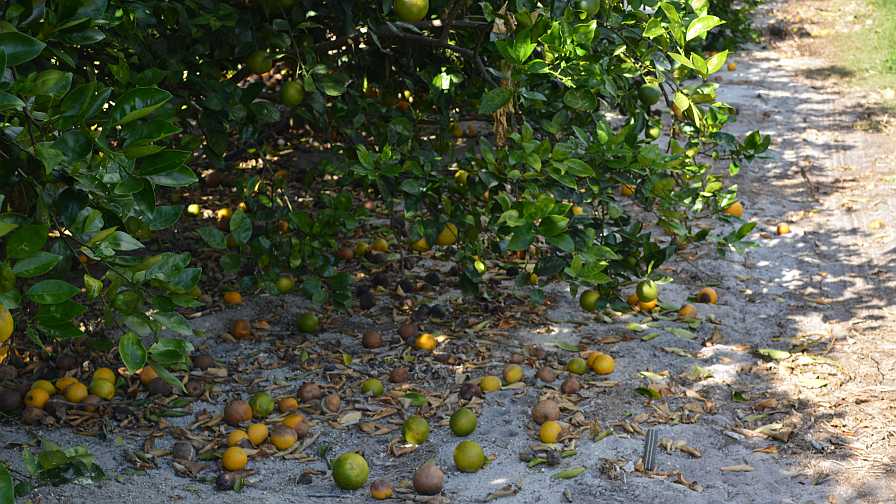
The incidence of citrus fruit drop in Florida orange groves has risen in recent years. Photo by Frank Giles
Fruit drop has always occurred in Florida citrus groves, but it has become increasingly problematic in recent years. HLB is certainly a major culprit in fruit drop. Tripti Vashisth, an Assistant Professor of Horticultural Science and a Citrus Extension Specialist, has been studying the problem to learn more about the origins of fruit drop and what you can do about it.
Her work has revealed that the process of drop begins well before the fruit hits the ground. She says the internal signals for fruit drop appear months before harvest in the flower and bud development stages.
“We found that these signals can be detected in February in the case of Valencia,” Vashisth says. “This all basically means that the fate of the fruit is already decided by harvest time. So, when growers actually see fruit drop, it’s too late to do anything.”
What Can Be Done?
While HLB intensifies fruit drop, Vashisth says her research has shown that a good canopy equals less fruit drop. Shoot dieback is highly correlated with the severity of HLB infection in a tree. Thus, fruit drop severity follows along with the level of HLB infection.
In addition, oxidative stress leads to more dieback. Exposure to a variety of environmental factors such as salinity, drought, metal toxicity, extreme temperature, air pollutants, pesticides, and pathogen infection lead to oxidative stress in plants.
So, much of what you have been doing to enhance plant nutrition is important. Irrigation also is a key factor. Because HLB-affected trees have smaller root mass, water and nutrient uptake are limited. This reinforces the recommendation of spoon-feeding water and nutrients.
“Frequent irrigation with the same amount of water but applied more often is important,” Vashisth says. “Also, it is essential to improve irrigation strategy during the time of fruit set.”
She has observed that small-sized fruit is more apt to drop. Fruit size is driven by water availability. Typically, April and May are dry periods. This also is a critical fruit set and early development period, so irrigation is critically important during this timeframe.
Vashisth also has been experimenting with gibberellic acid (GA) to see if it might provide some benefit of helping fruit hold onto the trees. Abscisic acid seems to be involved in triggering fruit drop, and GA is thought to counter that.
“We have been experimenting with it on one grower’s block and have been seeing positive results for the past three seasons,” she says.
Fall applications of GA have resulted in larger fruit, which are less apt to drop. This application, made in the September to January timeframe (20 gallons of AI/acre), has shown improved fruit retention. The application also showed a yield increase in ‘Valencia’.
Vashisth says more research is underway to determine if GA improves HLB-affected tree health. This research will dig deeper into rates and timing of GA applications.
More to Learn
Another experiment Vashisth has launched this season aims to determine the effect off-season or prolonged flowering and fruit set has on drop.
“Basically, I am trying to learn if fruit that sets at the end of January will fall sooner and fruit setting in March will drop later. Does that equate to more fruit drop with off-season fruiting?” she asks.









